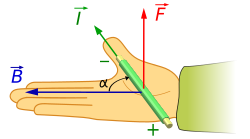trendsetter37
The Living Force
hlat, does this visual help? With the red arrow representing the direction of the Lorentz force (that will act on charged particles, seemingly everything to some extent or another) that is present because of the electric and magnetic fields being present simultaneously.


_http://en.wikipedia.org/wiki/Lorentz_force said:When a wire carrying an electrical current is placed in a magnetic field, each of the moving charges, which comprise the current, experiences the Lorentz force, and together they can create a macroscopic force on the wire (sometimes called the Laplace force[citation needed]). By combining the Lorentz force law above with the definition of electrical current, the following equation results, in the case of a straight, stationary wire:
F = I ℓ X B
where ℓ is a vector whose magnitude is the length of wire, and whose direction is along the wire, aligned with the direction of conventional current flow I.
If the wire is not straight but curved, the force on it can be computed by applying this formula to each infinitesimal segment of wire dℓ, then adding up all these forces by integration. Formally, the net force on a stationary, rigid wire carrying a steady current I is
F = I ∫ d ℓ X B
This is the net force. In addition, there will usually be torque, plus other effects if the wire is not perfectly rigid.
One application of this is Ampère's force law, which describes how two current-carrying wires can attract or repel each other, since each experiences a Lorentz force from the other's magnetic field. For more information, see the article: Ampère's force law.

